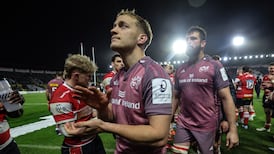AMERICA AT LARGE:World heavyweight champion Gene Tunney enjoyed a long friendship with George Bernard Shaw, a boxing aficionado
FOUR YEARS ago I was a participant, along with the late Budd Schulberg, sportscaster Jeremy Schaap and Jay Tunney, in a panel discussion at the Irish Arts Center in New York. At some point in the evening I recall turning to Jay and telling him how much I’d have loved to have been a fly on the wall at some of those famously elegant soirees his parents hosted at Star Meadow Farm, their palatial Connecticut estate, “if only to eavesdrop on the dinner conversation between Roy Rogers and George Bernard Shaw”.
What I didn't realise was that Jay Tunney had already devoted more than a decade to compiling an account of his father's (mostly) post-boxing career, one centred on Gene Tunney's enduring friendship with Shaw. The US publication of The Prizefighter and the Playwrightwill officially be celebrated this evening at the National Arts Club in Gramercy Park.
Born in 1897 of Mayo immigrants, James Joseph Tunney was, despite having dropped out of school at the age of 12, arguably the most cerebral, and certainly the best-read, boxer ever to hold the heavyweight championship of the world. A voracious reader from an early age, he maintained a little black book of unfamiliar words, which he committed to memory after looking up their meanings – and pronunciations. Somewhat embarrassed by his lack of formal education, he assiduously polished his diction, eradicating every vestige of a plebian New York street accent.
He was introduced to the bard by a fellow marine en route to France with the American Expeditionary Force; by the time he fought for the heavyweight championship he had plowed his way through the collected works of Shakespeare, and could recite Hamlet in its entirety. Invited to Yale to lecture on Shakespeare, he did so creditably, and without notes.
Tunney's intellectual bent was not universally admired. Will Rogers (no relation to Roy), wrote in his folksy newspaper column, "Let's have prizefighters with harder wallops and less Shakespeare", and Paul Gallico, the Columbia-educated sports editor of the New York Daily News, made light of Tunney's chances in his 1926 challenge to Jack Dempsey, opining: "I think Tunney has hurt his own game with his cultural nonsense.
"I don't think Master Tunney, who likes first editions and rare paintings and works of art, has it in him," wrote Gallico, who a decade later would abandon sportswriting and move to the Riviera, where he devoted the rest of his life to writing timeless classics like The Poseidon Adventure.
If the sporting press was reluctant to embrace a practicing pugilist whose erudition outstripped theirs, the boxing public was almost hostile – in part out of resentment for what it considered Tunney’s “high-hat” pretensions, and in an even larger measure due to its unwavering loyalty to the man over whose back Gene had climbed to reach the pinnacle of his profession.
Last year another former heavyweight champion, Larry Holmes, told the story of encountering what appeared to be a sweet little old lady whose first words were “I hate you”. Nearly 30 years after the fact, the dowager still regarded Holmes’ 1980 battering of the aging Muhammad Ali a crime against humanity, in much the same manner boxing fans of an earlier generation considered Tunney’s back-to-back victories over the popular Jack Dempsey beyond forgiveness.
If Tunney’s 1926 decision in Philadelphia had confounded boxing experts, who had almost unanimously picked against him, it did not entirely surprise a Dublin-born playwright living in London. Although George Bernard Shaw and Tunney had yet to meet, Shaw had watched newsreels of Tunney’s 1924 dismemberment of Georges Carpentier, and, much as he admired Dempsey, he had predicted that the Manassa Mauler’s undoing would eventually come in the form of a “scientific boxer” who could exploit the champion’s brawling style.
A knowledgeable boxing fan throughout his life, Shaw had briefly dabbled in the sweet science – he was listed in the programme as a contestant in the 1883 Queensberry Championships in London, although no record exists of his having appeared in a bout – before settling more comfortably into an analyst's role in covering major fights for various publications. A boxer had been his protagonist in Cashel Byron's Profession, one of the five novels he wrote before turning to the stage. A year before Tunney beat Dempsey, Shaw had won his version of the heavyweight championship when he was awarded the Nobel Prize for Literature.
Shaw also appeared to share Tunney’s low regard for the sportswriting profession, having once suggested the passage of a bill “making it a punishable offence for a newspaper to order or publish any description of a prizefight until they had sent for a professional boxer and made the writer spar a bye with him, and obtain from a couple of competent judges a certificate that he at least knows his right hand from his left”.
If Tunney had imagined that the heavyweight title would bring public acceptance, he was quickly disabused. Weeks after the first Dempsey fight, the old and new champion were presented in the ring at Madison Square Garden. Dempsey was lustily cheered; Tunney’s reception consisted for the most part of boos and catcalls. Even Dempsey found it embarrassing.
“Practically overnight,” Gene Tunney recalled the moment, “I had become the most unpopular of all the heavyweight champions.”
Although Tunney engaged in 85 professional bouts over a 13-year career barely interrupted by his wartime service (he had nine fights in France in 1918-19, before and after the armistice), his reign as heavyweight champion was brief: he successfully defended in the 1927 Chicago rematch with Dempsey (the fabled “Long Count” fight, in which Tunney was knocked down for the only time in his career), fought brilliantly in stopping the overmatched New Zealander Tom Heeney at Yankee Stadium in 1928, and then a few days later shocked the world by announcing his retirement at the top of his game.
The title did, on the other hand, provide entrée to the cultured circles he had long regarded. Tunney had long admired Shaw. He considered Saint Joana masterpiece (and later named his only daughter Joan). His early efforts at upward mobility through improved diction had been inspired by Shaw's depiction of Eliza Doolittle in Pygmalion. And, writes Jay Tunney, Cashel Byron's Professionwas a virtual roadmap for his father's social aspirations:
“With Cashel as a role model, Gene had permitted himself to envision a gentlemanly life beyond the ring as a realistic alternative, not a pipe dream. Even more significantly, Shaw’s Cashel allowed Gene to consider marriage beyond his own class, to a woman far removed from his world.”
The latter was borne out by his courtship of Polly Lauder, a Connecticut socialite and heiress to the Andrew Carnegie fortune. Their happy marriage endured until Tunney’s death in 1978. One of their sons, John V, was Ted Kennedy’s roommate at the University of Virginia law school and later joined Kennedy in Washington when he was elected to the US Senate in 1970.
The Tunney-Shaw relationship, on the other hand, very nearly got off on the wrong foot. In discussing his envisioned starring role in a movie version of Cashel Byron's Profession(the pretence was that the proposal had come from some Hollywood mogul; in fact, it had been Tunney's idea), Tunney had suggested that Cashel's character needed to be redrawn to reflect more accurately the mindset of a real boxer, remarks which, by the time they made their way to Fleet Street, ran under a banner headline "Tunney Takes a Swing at Shaw".
And Shaw, for his part, was all for updating his tale of 19th century pugilism, but wanted to write in a part that would also incorporate Dempsey’s acting talents.
Shaw was the most prominent of a small army of artistic types whose friendship Tunney valued. F Scott Fitzgerald had been a card-carrying member of the Tunney entourage even before the Dempsey fights. While in Europe just before his Rome wedding, Tunney was a guest of the tenor John McCormack at Moore Abbey in Kildare. He went climbing in the Alps with the author and playwright Thornton Wilder, and it was Wilder who introduced him, in Paris, to Ernest Hemingway. (The origins of Tunney’s relationship with Roy Rogers, alas, will have to await a sequel: “The Prizefighter and the King of the Cowboys”, perhaps?)
Probably fortunately, the film version of Cashel was never made, removing the last potential impediment to a fast friendship that endured from their first meeting until Shaw’s death in 1950. Shaw even wound up accompanying the Tunneys on their inadvertently extended, month-long honeymoon on the Italian isle of Briona (now part of Croatia), occasioned when Polly was stricken with a near-fatal internal infection.
For the next 20 years the by-then ex-prizefighter and the playwright 40 years his senior visited one another in their homes and maintained a lively transoceanic correspondence in which boxing, the subject that had drawn them together, was rarely even mentioned.










